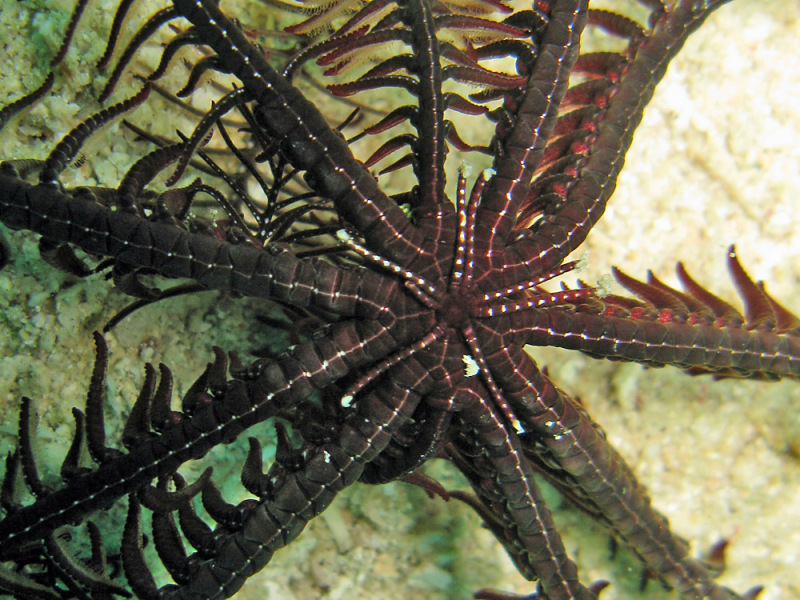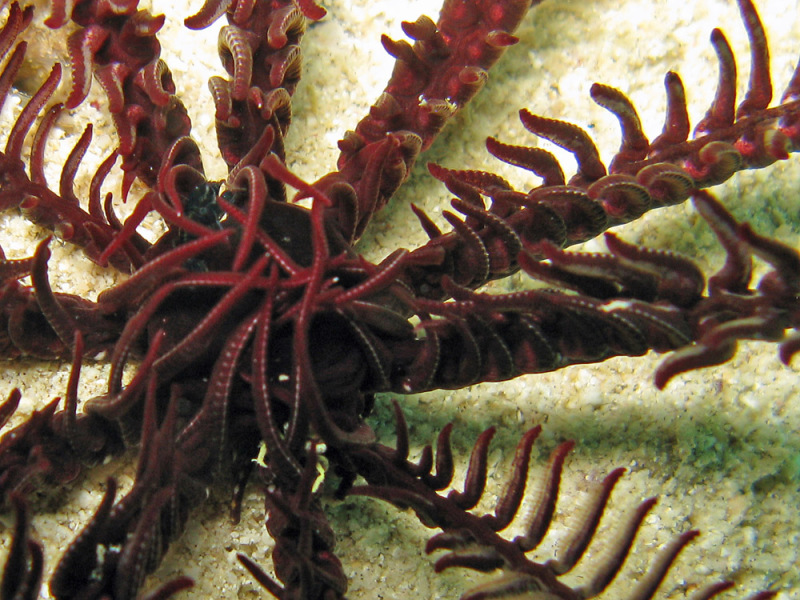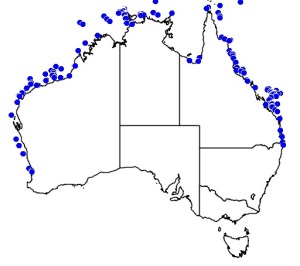
©Anne Hoggett: Under side of Comatula pectinata from shallow water at Lizard Island. This is a rare 11-armed specimen.

©Anne Hoggett: Upper side of Comatula pectinata from shallow water at Lizard Island. Oral pinnules are covering the disc. The comb teeth cannot be seen in this photo.
Colours
Distinguishing features
Comatulids are distinguised from all other featherstar families by having terminal segments of the oral pinnules modified to form a comb. Comatulids also have a distinctive "feel" due to well developed hooks on most pinnules that cause them to cling like velcro.
Comatula pectinata is a small cryptic or semi-cryptic crinoid with only ten arms up to about 80 mm long. The arms are robust and move quite stiffly. There may be no cirri or a few small ones. The first arm syzygy is between brachials 1 and 2 and the second is often between 3 and 4.
The most common colour form of shallow reef specimens at Lizard Island is purple (appears black) with a very fine white midline on each arm on the underside. Specimens from deeper water on soft sediment are brown or deep red, often with white pinnule tips.
It is distinguished from the similar-looking Comatula solaris by having a shorter comb on the oral pinnules.
Size
- Up to 8 cm (Longest arm length.)
Depth range
- Depth range data is not yet available.
Synonyms
Similar taxa
-
Animalia:
species: Comatula solaris
Pinnule combs have many more teeth
Distribution
Distribution and habitat preferences
Usually found under slabs of rubble or entwined deeply within finely-branching corals such as Seriatopora. At deeper soft-bottom locations, it is partly concealed under sponges with a few arms exposed.
Found in many places around the Lizard Island group. It is particularly common on the reef flat beween South and Palfrey Islands. It is also common in deeper water on soft sediment. Two species may be involved. Messing et al. (2006) recorded it as Comatula cf. purpurea from deeper water.
Web resources
References
References that assist with identification
- Clark, A.M. and F.W.E. Rowe (1971). Monograph of shallow-water Indo-west Pacific echinoderms British Museum (Natural History), London.
- Summers, M. M., C.G. Messing and G.W. Rouse (2014). Phylogeny of Comatulidae (Echinodermata: Crinoidea: Comatulida): A new classification and an assessment of morphological characters for crinoid taxonomy, Molecular Phylogenetics and Evolution, 80: 319-339. LIRS catalog number 1813.
Other references
- Messing, C.G., D.L. Meyer, U.E. Siebeck, L.S. Jermiin, D.I. Vaney and G.W. Rouse (2006). A modern soft-bottom, shallow-water crinoid fauna (Echinodermata) from the Great Barrier Reef, Australia, Coral Reefs, 25: 164-168. LIRS catalog number 956.
- View all references










